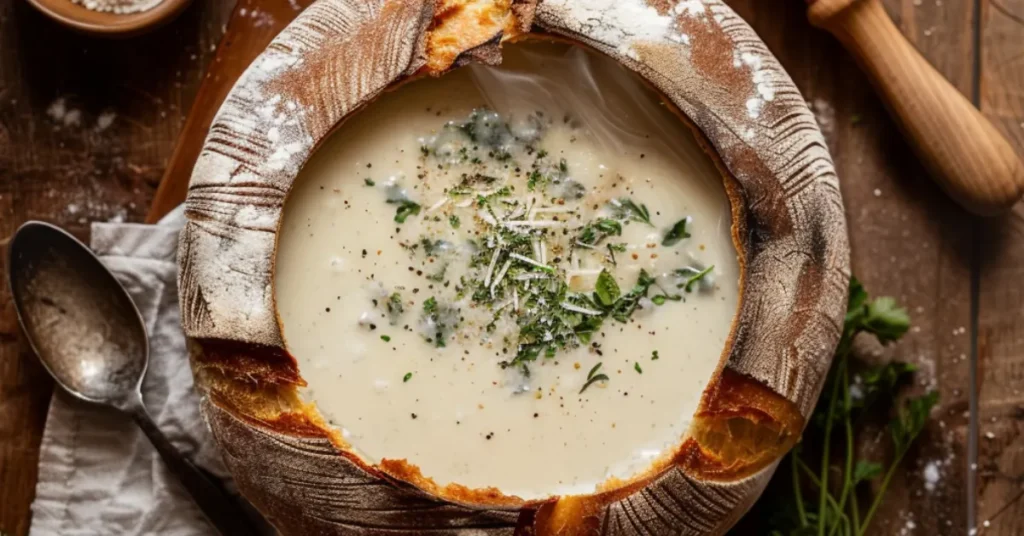Table of Contents
Sourdough has captivated the hearts of artisan bakers and food enthusiasts worldwide, offering a unique blend of tangy flavors, chewy textures, and a touch of tradition in every bite. Among the myriad of ways to enjoy sourdough, the sourdough bowl stands out as a creative and delicious vessel for a variety of dishes.
This guide will take you through the journey of crafting the perfect sourdough bowl, from the basics of sourdough preparation to advanced baking techniques and beyond.
The Basics of Preparation
Before diving into the art of making a sourdough bowls, understanding the foundation of sourdough itself is crucial. The choice of flour and the health of your starter are pivotal to your success. This section will cover how to select the right ingredients and maintain a vigorous starter, setting the stage for a perfect sourdough bowls.
Crafting Your First
Embarking on the journey of baking your first sourdough bowl is an exciting venture into the world of artisan bread making. This unique culinary creation not only serves as a delicious bread but also doubles as an edible vessel for a variety of dishes, from hearty stews to fresh salads. Below, we’ll guide you through the process, offering tips and insights to ensure your success.
Gathering Your Ingredients and Tools
Before you begin, it’s essential to have the right ingredients and tools at your disposal. For a basic sourdough bowl, you will need:
- Sourdough Starter: The heart of any sourdough recipe, ensuring your starter is active and bubbly is crucial.
- Flour: A high-quality bread flour is recommended for its higher protein content, which aids in gluten development.
- Water: Use lukewarm water to help activate the yeast.
- Salt: Enhances flavor and regulates yeast activity.
In terms of tools, a mixing bowl, a dough scraper, a kitchen scale for precise measurements, and a proofing basket (or a bowl lined with a well-floured towel) are essential. Additionally, a sharp knife or lame will be needed for scoring the dough.

Mixing and Kneading Your Dough
- Mixing: Start by combining your flour, water, and sourdough starter in a large mixing bowl. Mix until just combined, then let the mixture sit for about 30 minutes for autolysis, which helps gluten development.
- Kneading: After the autolysis period, add salt to your dough, then knead in the bowl or on a clean surface until the dough becomes smooth and elastic. This process can take about 10 to 15 minutes by hand. You’re aiming for a dough that’s tacky but not overly sticky.
More recipes: San Giorgio Lasagna Recipe
Bulk Fermentation
Place your kneaded dough back into the mixing bowl, cover it with a damp cloth or plastic wrap, and let it sit at room temperature. This bulk fermentation stage is crucial for flavor development and can take anywhere from 4 to 12 hours, depending on your kitchen’s temperature and the activity level of your starter. The dough should roughly double in size and show signs of bubbles and increased volume.
Shaping
Once your dough has fermented:
- Gently deflate the dough on a lightly floured surface.
- Shape the dough into a tight ball by pulling the edges into the center and then flipping the dough over, cupping your hands around it to create surface tension.
- Proofing Basket: Place the shaped dough seam-side up into a well-floured proofing basket or a bowl lined with a floured towel. This second rise, or proofing stage, allows the dough to develop its final shape and size. It generally takes about 1 to 2 hours but can vary based on environmental factors.
Baking
Preheat your oven to a high temperature (around 450°F or 230°C) with a dutch oven or baking stone inside. Once preheated:
- Score: Carefully turn your dough out onto a piece of parchment paper and make a few shallow cuts on the top with a sharp knife or lame. Scoring controls how the dough expands in the oven.
- Bake: Place the dough (with the parchment paper) into the preheated dutch oven or onto the baking stone. If using a dutch oven, cover it to create a steamy environment that helps achieve a crispy crust.
- Bake for about 20 minutes with the lid on, then remove the lid and reduce the oven temperature to 400°F (205°C). Continue baking for another 20-25 minutes until the bowl is golden brown and sounds hollow when tapped on the bottom.
Cooling and Serving
Allow your sourdough bowl to cool on a wire rack for at least an hour before cutting into it. This resting period is crucial as it lets the crumb set and the flavors develop further.
Congratulations! You’ve just crafted your first sourdough bowl. These bowls are perfect for filling with your favorite soups, stews, or salads. Enjoy the fruits of your labor by sharing a meal served in your homemade, edible bowls.
Crafting a sourdough bowl from scratch is a rewarding experience that combines the art of baking with the joy of cooking. With practice, each bowl will become a testament to your growing skills as an artisan baker. Remember, sourdough baking is as much about the journey as it is about the delicious results. Happy baking!
Sourdough Bowl Recipes for Every Occasion
Sourdough bowls are not just a treat for the senses with their tangy flavor and hearty texture; they also serve as versatile vessels for a myriad of delicious fillings. Whether you’re looking for a cozy breakfast option, a comforting lunch, or a satisfying dinner, sourdough bowls offer the perfect canvas for culinary creativity.
Here, we explore a collection of sourdough bowl recipes tailored for every occasion, ensuring that your meals are not only nourishing but also exciting and varied.
Breakfast Bowls: A Hearty Start to Your Day
Starting your day with a sourdough bowl can provide the energy and satisfaction needed to tackle your tasks. Here are two breakfast bowl ideas:
- Egg and Avocado Breakfast Bowl: Scoop out a bit more from your sourdough bowl to create space. Brush the inside with olive oil and crack an egg into each bowl. Bake until the eggs are set but still soft. Top with sliced avocado, crumbled bacon, and a sprinkle of cheddar cheese for a rich and fulfilling start to your day.
- Berry and Yogurt Bowl: For a lighter, refreshing start, fill your sourdough bowl with Greek yogurt. Top with a mix of fresh berries, a drizzle of honey, and a sprinkle of granola for crunch. This combination offers a delightful contrast of tangy sourdough with sweet, creamy, and crunchy textures.
Lunch Bowls: Midday Meals to Recharge Your Energy
Lunch is the perfect time to refuel, and a sourdough bowl can turn a simple meal into something special.
- Classic Clam Chowder in a Sourdough Bowl: Fill your sourdough bowl with rich, creamy clam chowder. The tangy sourdough complements the savory flavors of the soup, making for a classic San Francisco dining experience right at home.
- Mediterranean Chickpea Salad Bowl: Combine chickpeas, diced cucumbers, tomatoes, red onion, feta cheese, and olives for a Mediterranean-inspired salad. Dress with olive oil and lemon juice, then spoon into your sourdough bowl for a refreshing and filling lunch.
Dinner Bowls: Comforting Meals to End Your Day
Dinner in a sourdough can be both comforting and sophisticated, providing a warm end to your day.
- Beef Stew Sourdough Bowl: A hearty beef stew, with tender chunks of beef, potatoes, carrots, and peas in a rich gravy, becomes a comforting dinner when served in a sourdough . The bowl soaks up the gravy, making every bite delicious.
- Roasted Vegetable and Quinoa Bowl: For a lighter dinner option, fill your sourdough with a mix of roasted vegetables (like bell peppers, zucchini, and cherry tomatoes) and quinoa. Drizzle with a balsamic glaze for a meal that’s both healthy and satisfying.
Dessert Bowls: Sweet Treats to Delight
Even dessert can be served in a sourdough, offering a unique twist on traditional sweets.
- Chocolate Fondue Bowl: Melt your favorite chocolate and pour it into a small sourdough bowl. Surround it with fruit slices, marshmallows, and biscotti for dipping, creating a fun and interactive dessert.
- Ice Cream Sundae Bowl: Scoop your favorite ice cream flavors into a sourdough bowl. Top with hot fudge, whipped cream, and a cherry for a decadent dessert that combines the cool sweetness of ice cream with the slight tang of sourdough.
Seasonal and Special Occasion Bowls
Don’t forget that sourdough bowls can be adapted for seasonal ingredients or special occasions, making them a versatile choice for any event.
- Pumpkin Soup Bowl for Fall: Serve a creamy pumpkin soup in a sourdough bowl for a warm, autumnal meal.
- Seafood Bisque for Celebrations: Elevate your celebrations by serving a luxurious seafood bisque in a sourdough bowl, perfect for impressing guests.
Sourdough bowls offer endless possibilities for creative and delicious meals, regardless of the occasion. By incorporating these recipes into your meal planning, you can enjoy the unique combination of flavors and textures that only a sourdough bowl can provide. Whether you’re a seasoned baker or a culinary enthusiast, these sourdough bowl recipes are sure to inspire and delight.
Troubleshooting Common Sourdough Bowl Issues
Crafting the perfect sourdough bowl can sometimes feel like an art form, filled with as much potential for frustration as there is for satisfaction. Whether you’re a seasoned baker or a newcomer to the world of sourdough, encountering issues along the way is a normal part of the learning process.
This guide aims to address some of the most common sourdough bowl problems, offering practical solutions to help you achieve baking success.
Issue 1: Sourdough Bowl is Too Dense
A dense sourdough bowl often results from insufficient fermentation or an underdeveloped gluten network.
- Solution: Ensure your starter is active and bubbly before using it. Allow your dough to ferment in a warm, draft-free area to encourage yeast activity. Additionally, knead your dough adequately to develop a strong gluten network, which will help trap the gases produced during fermentation, leading to a lighter, airier structure.
Issue 2: The Crust is Too Hard or Thick
While a certain degree of crustiness is desirable, an overly hard or thick crust can detract from the enjoyment of your sourdough bowl.
- Solution: To achieve a thinner, softer crust, try steaming your oven during the initial phase of baking. You can do this by placing a pan of water on the bottom rack of your oven or spraying the walls of the oven with water. This creates a humid environment that helps soften the crust. Additionally, consider reducing the baking time or temperature slightly, keeping a close eye on your dough to prevent underbaking.
Issue 3: Sourdough Bowl Loses Shape
A sourdough bowl that spreads out too much and loses its shape is often a sign of over-proofing or a wet dough.
- Solution: To prevent over-proofing, pay close attention to your dough during the fermentation process and perform the poke test: gently poke the dough with your finger; if it springs back slowly and leaves a small indentation, it’s ready to bake.
- If it’s overly sticky or slack, consider reducing the hydration level in your recipe or incorporating more flour during kneading to achieve a firmer dough that holds its shape better.
Issue 4: Sourdough Bowl is Undercooked Inside
An undercooked sourdough bowl can result from too high an oven temperature or insufficient baking time.
- Solution: Ensure your oven is preheated to the correct temperature and consider using an oven thermometer to verify accuracy. Bake your sourdough bowl for the recommended time, and don’t hesitate to extend the baking period if necessary. The internal temperature of a fully baked sourdough bowl should reach approximately 200°F (93°C). Allowing your dough to bake thoroughly ensures the inside is fully cooked before the crust becomes overly browned.
Issue 5: Sourdough Bowl Lacks Flavor
Developing the deep, tangy flavor associated with sourdough requires time and the right conditions.
- Solution: Extend the fermentation time to allow more complex flavors to develop. Consider using a cold fermentation method by placing your dough in the refrigerator for a slow, extended rise. This not only enhances the flavor but also improves the texture of your sourdough bowl. Additionally, experiment with different types of flour to find the one that best suits your taste preferences.
Issue 6: Sourdough Bowl Has a Gummy Texture
A gummy texture can be the result of underbaking or slicing into your sourdough bowl too soon after baking.
- Solution: Ensure your sourdough bowl is fully baked by checking its internal temperature and allowing it to bake until it reaches the right doneness. After baking, it’s crucial to let your sourdough bowl cool completely on a wire rack before cutting into it. The cooling process allows the steam to escape and the crumb to set, preventing a gummy texture.
By addressing these common issues, you can enhance your sourdough bowl baking skills and enjoy the process of creating delicious, artisanal bread bowls at home. Remember, sourdough baking is as much about patience and practice as it is about precision. Embrace the challenges, and enjoy the journey toward sourdough perfection.
FAQs About Sourdough Bowls
Why is my sourdough bowl dense?
A dense bowl often results from under proofing, an inactive starter, or insufficient gluten development. Ensure your starter is active, let the dough rise until doubled, and knead well.
How to prevent a crusty sourdough bowl?
For a softer crust, add humidity in the oven with a pan of water or by spraying water. Covering the bowl with foil in the latter baking stage can also help.
Best storage method for sourdough bowls?
Store at room temperature in a bread box or wrapped in a cloth inside a paper bag for up to 3 days. For longer storage, freeze wrapped in plastic and foil.
Can I make sourdough bowls in advance?
Yes, bake, cool, and store as recommended. Reheat in the oven at 350°F for 10 minutes before serving.
Why won’t my sourdough bowl hold its shape?
This could be due to over-proofing, high hydration, or weak gluten structure. Shape tightly, adjust hydration, or knead thoroughly.
Can whole wheat flour be used for sourdough bowls?
Yes, but adjust hydration as whole wheat absorbs more water. For a lighter texture, mix with white flour.
How to tell if a sourdough bowl is fully baked?
It should sound hollow when tapped and reach an internal temperature of 200°F. A deep golden




